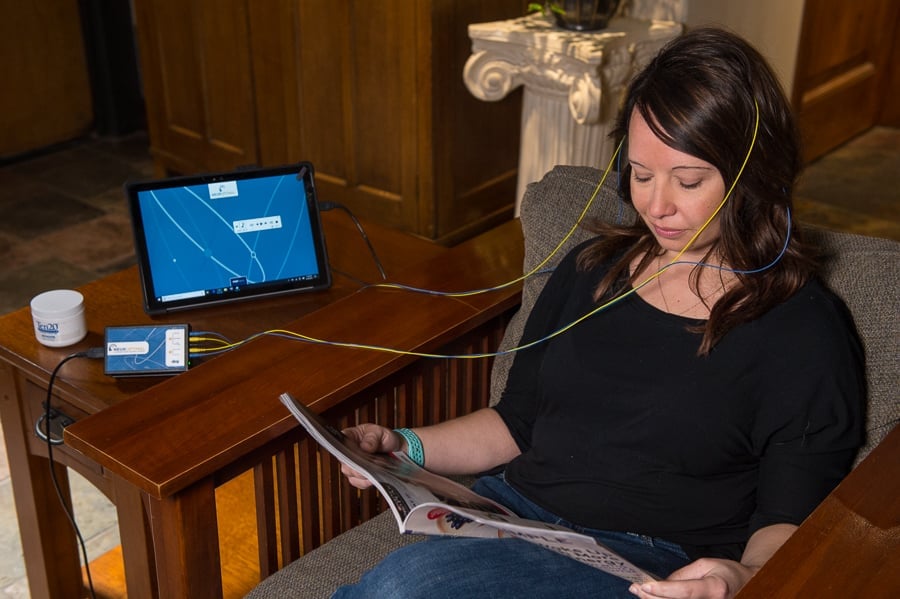Family Matters: 5 Ways to Boost the Effectiveness of Neurofeedback Training
 Why we recommend that a parent also train if they are renting a machine primarily for their child’s issues.
Why we recommend that a parent also train if they are renting a machine primarily for their child’s issues.
Your child’s brain/central nervous system (CNS), is learning to assess current needs from gathering information in the here-and-now, rather than using habitual information/neural pathways. “An ineffective Brain” prone to heightened feelings of anger, worry and nervousness are the result of maladaptive brain responses that are based on using habitual information/neural pathways to function not realizing that those responses are not appropriate to the present task. (For example, why should the brain produce an fear state when their is no threat?) A major shift through training is your child’s brain learns to be in a state called regulation: calm, alert, and open to the here-and-now, and only become active only when their is an event that needs action.
This process of learning is sped up when a primary caregiver’s brain is also learning the same process of being regulated–calm, centered, open. Why? Because just like you see in pack animal behaviors, children’s brains tune themselves to their caregivers’ brains. If the parent is anxious, the child will also become anxious. If the parent becomes calm the child’s brain will also shift, like tuning forks resonating with each other. A wonderful example of this process of attunement is to watch The Dog Whisperer on National Geographic. In the episodes you will see examples of how Cesar (the alpha dog trainer) who is “calm assertive”, i.e. has a regulated CNS, works with an anxious/fearful/aggressive dog through the natural attunement process where a beta dog’s CNS aligns with an alpha’s CNS.
Neurofeedback Training Benefits
1. Two is better than one!
We are pack animals and betas follow the alpha. When an “alpha” member (hopefully you read: parent) trains it helps the “beta” brains and boosts the effectiveness of their training. Why? Think of tuning forks that are close together. They will resonate at the same pitch. Mom and Dad’s nervous systems are a powerful ‘tuning fork’ for kids. If their brains train and come into regulation—that calm, focused, playful ‘pitch’—it is much easier for the child’s nervous system to resonate at that pitch.
 2. Put neurofeedback training on the schedule.
2. Put neurofeedback training on the schedule.
The most common ‘complaint’ I hear when clients return a rental machine is “I loved it. I just wish we had trained more!” Like anything we want to accomplish in our busy lives: if it’s not on the schedule it won’t happen. Make it a realistic time when you can count on 45 minutes of free time. And make sure that second family member is on a schedule too!
3. Make training a reward.
Bill, a successful entrepreneur, who rented a home neurofeedback system, never missed a session. He told himself that during his training time he didn’t have to accomplish anything else. It became the two times during the week when he truly let himself relax. A gift to his brain and his go-getter mind!
4. Listen to your body and get sleep.
After ten sessions a client said to me, “Natalie, since starting I’m noticing how exhausted my body is. All I want to do is sleep!” This observation is common and some people try to push through it and maintain their 6 hours of sleep a night, while others yield and get more rest. Remember: a main purpose of sleep is to give the brain time to remove toxins that have built up throughout the day. Your brain is asking for what it needs to optimize it’s functioning. Please listen!
5. Get the toxins out of your life and replace them with nutrients.
The brain is only as effective as the building blocks it has to build and repair its roads and highways. One main toxin in our lives is sugar. The vitamin we’re often depleted in is Vitamin D—essential for our cheerful disposition. A trained brain becomes a better communicator of its needs. Pay attention you may have thoughts like: maybe I should do that cleanse I was thinking about. Or I should get a physical and check on my vitamin levels. A great place to start is on Dr. Hymen’s website.


